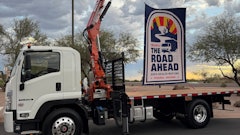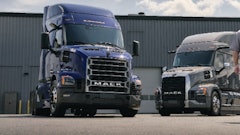
With diesel prices at record highs, it pays to take steps to optimize fuel economy for your vehicle fleet. A good starting point is driver training.
"Of all of the factors that affect fuel consumption, drivers have the most influence on fuel economy," says Matt Gervais, heavy-duty product strategy manager, Sterling Trucks.
"Operators typically influence overall fuel economy by as much as 35%," says Christy Nycz, Cummins. "Operator training and implementation of electronic control module features [i.e., road speed limits] are key to reducing this disparity."
Gervais recommends training drivers to anticipate road speed changes; plan routes to minimize stops; avoid unnecessary engine idling; minimize accessory loads on the engine (air conditioning, fan-on time, etc.); keep rpms low and running in the "sweet spot"; optimize shift points; and use cruise control wherever possible. "Drivers who are trained in these techniques can improve fuel economy by up to 35%," he adds.
Driving techniques
Speeding dramatically increases fuel consumption. This is especially true for vocational trucks, which exhibit many aerodynamic inefficiencies vs. their over-the-road counterparts. "The losses [in fuel efficiency] are somewhat greater due to the lack of aerodynamic aides and the irregular loads typically hauled by vocational applications," says Nycz.
Slowing down even a little can have an impact. "Slowing speeds by 1 mph on a vocational vehicle can result in a 2% to 3% fuel savings," says Gervais, "and slowing speeds by 5 mph can result in a 10% to 15% fuel savings."
Rapid acceleration should also be avoided whenever possible. "Instead, utilize a progressive shifting technique," says Mike Powers, global on-highway product development manager, Caterpillar. "Operate in the highest gear possible. Do not run one gear down unless operating in conditions requiring it in off-road applications." Keep the engine below 1,500 rpm (unless you have a heavy-haul application with a truck spec'd at 1,600 rpm), and downshift around 1,100 rpm.
Throttle applications should be smooth. "When accelerating, pretend there is a raw egg between your foot and the throttle pedal and the goal is not to make a scrambled egg," suggests David McKenna, powertrain products marketing manager, Mack Trucks. "There are exactly zero good reasons to give 100% throttle input to a Mack MP Series engine, whether from a start or even accelerating to pass."
He points out, "Every single time you accelerate at full throttle to well above 1,600 rpm ? even for a few seconds ? throw a quarter out the cab window, as that is your real return on fuel economy."
McKenna advocates watching your shift points. "Generally speaking, anything above 1,600 rpm turns very expensive diesel fuel into noise," he points out. "There is not much to be gained from engine braking vs. service brakes... The idea here is to avoid being constantly heavy on the throttle and on the brakes. Allow a distance between vehicles so you can coast or cruise."
"While coasting in gear, the engine consumes zero fuel," explains Powers. "Rather than braking hard for stops and/or exit ramps, back out of the throttle early and allow the vehicle to coast as far as possible. The rotation of the drivetrain will keep the engine rotating and all of the fuel pumped to the engine will be returned to the fuel tank. Once the engine goes into idle rpm, it will start burning fuel again. Any distance you can coast in gear is completely free mileage."
The influence of temperature
"An engine always performs better at operating temperatures," says McKenna. "However, there are many different weather zones, so differing practices should be used that are practical for your area. After a good cold soaking over a weekend, I would be inclined to allow the coolant temperature to reach approximately 100° F before moving. Where the climate may be somewhat more favorable ? anything above 40° F ? [move] as soon as the oil and air pressures have stabilized."
However, keep warm-up time to the minimum required. "Warming up the engine uses fuel with no resulting mileage, and therefore has a negative effect on fuel economy," says Gervais. Warm-up time should be minimized to just enough to ensure proper operation.
In fact, any idling is detrimental to fuel economy. "Depending upon the amount of auxiliary drive load on the engine, it can consume anywhere from 1/2 to 1 1/2 gal. of fuel per hour," says Powers. "Fuel economy improves up to 4% with a reduction in idle time from 50% to 25%. Excessive idling wastes fuel, adds contaminates to the oil and adds carbons to the combustion chamber of your engine."
Remember that cooling fans also consume horsepower, which reduces fuel economy. "Under normal operating conditions, leave the fan switch in the automatic mode while driving, which allows the fan to activate only when needed," says Powers.
Strike the proper balance
"Correct entire vehicle spec'ing is the second major area of fuel consumption performance," says McKenna.
You need to carefully evaluate the trade-offs. "Spec'ing is a balance between performance and fuel economy," says Powers. "Vehicles must be spec'd to meet the startability and gradability requirements for a given application. But these requirements must be met while maximizing the fuel economy potential of a given vehicle. This requires that the engine be spec'd to operate at the lowest engine speed at cruise as possible, while meeting the performance requirements of the vehicle."
Powers adds, "The Truck Maintenance Council has stated you could see up to a 3% reduction in fuel economy in vehicles spec'd to run 100 rpm higher than the engine manufacturer's recommendation."
Tire selection has a major influence on fuel economy. "Careful selection of tires that are made for the application with the least amount of rolling resistance can improve fuel economy by up to 2% over standard tires," says Gervais.
"Deep lugs have better traction, but have high rolling resistance," Powers notes. "Shallow lugs reduce the tread depth to decrease the rolling resistance. Ribs sacrifice traction, but offer lower rolling resistance and better fuel economy."
Tire choice really needs to be weighed against the specific duty cycle to determine the best overall value. "A highway tread may offer the lowest rolling resistance, but you can easily get stuck on a jobsite. Conversely, a severe-duty lug tire that sees very little true off-highway work may last forever, but it has nasty rolling resistance," says McKenna. Thus, it pays to consult a tire expert.
"Truck weight is also an important factor," says Gervais. "Each 1,000-lb. reduction in weight can save between 1% and 1.2% in fuel, depending on terrain. Therefore, it is important to 'right size' the vehicle for the application. Don't over-spec the truck."
Size engines to the task
Perhaps one of the most critical truck specs is engine selection. Too small or large an engine will result in decreased efficiency.
"If you purchase a larger engine than required, the engine's efficiency may not allow for maximum fuel efficiency," says Powers. "Likewise, if you select a smaller engine that must operate outside of its optimum operating range and load factor, it may not provide optimum fuel economy for a given application."
"Larger, higher horsepower engines will burn more fuel due to the driver inputs," Nycz explains. "Let's face it, if a bigger engine gets you to the top of a mountain at a higher road speed, you will take advantage of it, thus burning more fuel than with a lower horsepower engine that will take longer to pull the same hill.
"That being said, there is some merit to spec'ing the right horsepower and torque combination for the job," she adds. "If the driver feels he has adequate power, he's usually less aggressive. This results in better mileage through enhanced driveability."
It really boils down to understanding the power requirements. "In most (not all) vocational operations, torque is much more significant than horsepower," says McKenna. "Low-end brute power, a.k.a. torque, is really what allows the work to be done in extreme conditions."
When it comes to choosing between a large- or small-displacement engine, sometimes the correct choice is not obvious. "The small vs. large displacement debate is really not that simple," says McKenna. "Several years ago, an engine manufacturer supplied two displacements from one block. To everyone's surprise, the larger displacement was somewhat better on fuel economy. This was because the horsepower density (horsepower per liter) was more balanced.
"Think of your engine as an air pump," he continues. "At which size can you most efficiently get the air and fuel in and the exhaust out efficiently? At Mack, we like to see something around 32 hp per liter +/- 3 hp in our MP7, and 34 hp per liter +/- 2 hp with our MP8 and MP10."
Always consider the environment in which you plan to operate the truck. "When spec'ing the vehicle, typical operating conditions should be identified (terrain, grades, road speed limits), so the proper gear ratios are selected to ensure adequate startability and operation without sacrificing fuel economy," says Gervais. "In addition, transmission features such as overdrive, automation and progressive shift programming can have a positive affect on fuel economy."
The power train must be designed to work together. "Gearing can have a negative impact on fuel economy by operating the engine outside of its sweet spot on the fueling tables," says Nycz. "Numerically higher axle ratios do improve startability and gradability, but at the cost of fuel economy.
"All engine manufacturers have minimum guidelines for these values to maximize performance and minimize fuel consumption," he continues. "The gearing requirements of a vocational application are usually numerically higher to allow satisfactory operation on off-road and soft surfaces."
Practice diligent maintenance
"With diesel currently above $4/gal., a comprehensive preventive maintenance program will pay for itself in fuel savings alone," says McKenna.
Gervais agrees, noting, "Maintaining engine components such as air and fuel filters keeps your engine running at peak performance, resulting in more efficient combustion and better fuel economy."
All maintenance factors affect some aspect of performance and fuel economy. "But the most critical maintenance issue that directly impacts fuel economy is air filter maintenance," says Powers. "The engine needs an unrestricted supply of clean air to operate efficiently."
Tire maintenance also ranks near the top. "Properly inflated tires mean less work will be required from the engine to move the vehicle, with the end result being improved fuel economy," says Gervais.
"Improperly inflated tires can drastically reduce fuel efficiency, as well as diminish the life expectancy of the tires," Powers adds. "For example, tires that are 10 psi low can decrease fuel economy by 0.5%."
Pay close attention to axle alignment, as well. "Axle misalignment will adversely affect fuel economy as much as 2.5%, depending upon the number of axles misaligned," says Nycz.
"Proper axle alignment reduces tire scrub, resulting in less resistance and improved fuel economy," says Gervais. "This holds true for tractor axles and trailer axles."
The importance of axle alignment to fuel economy really depends on how much time the truck spends on the road. "The greater the amount of time the vehicle spends at road speed, the greater the savings or cost," says McKenna.
Keep track
As with any performance criteria, tracking the impact of any changes is important if you expect results.
"Monitor the results of any changes to your operations ? such as road speed limits, idle shutdowns, PTO settings, tire type and tire size ? as it is possible to make fuel performance worse," says McKenna. "Make one change at a time so you can quantify the improvement for each change."




















